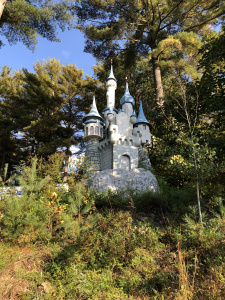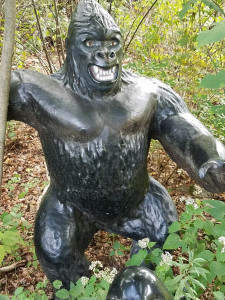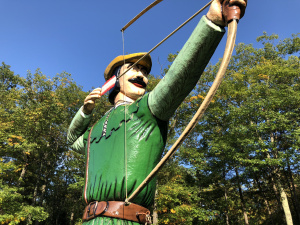Susan Daitch
Umwelt
The Magic Forest, an amusement park in Lake George, New York, was closing and so needed to put all the giant fiberglass statues up for sale. These included a fourteen-foot-high Robin Hood, a six-foot snail, a caveman, the Esso tiger, assorted clowns, a hot dog putting ketchup on itself, mustachioed acrobat in tights bending over, the Headless Horseman, figure of a girl who looked like Alice in Wonderland with a Minotaur head on her shoulders, a nineteenth century miner, hand on dynamite blasting box, a spaceman, to name just a few. The assorted clowns were truly scary, as were some of the elves with their fixed smiles, their wide-set asymmetrical eyes peering out from behind sumac trees or looking down from their perch on the Magic Arcade. These were more desirable than you might think, but the real prize was Paul Bunyan, still in original packaging, expected to be snapped up for $30,000. If all the figures sold, the new owners could net close to half a million dollars.
The park was founded in 1963, and family run since its inception, though some of the figures didn’t appear as if they were manufactured during the Johnson administration. They were of more recent fabrication but not at all generic, and looked like the work of an individual artist, his or her hand was evident in the facial expressions, from astronaut to top-hatted rabbit. It was someone’s job to decide which stories to represent and how to design them, and this seemed to me, growing up not far from the park, like a fantastic profession.

Lake George was the home of many amusement and theme parks, and my sisters and I looked forward to visiting them, but staring through the window of a copper-toned Rambler station wagon as we drove north, the contrast between the dense forest, far from any city, and the statues placed in either the Fairy Tale or Safari sections of the park couldn’t help but look odd, fun but starkly out of place. Someone’s imagination was plunked down here, someone’s dreams and nightmares, between the petting zoo, the rides, and US Route 9. The forest was always eating away at the edge, as if saying, okay for now, but we’ll be back.
Why did all these analogue amusement parks find a home, nestled near a northern lake, a taiga or snow forest dense with fir, larch, spruce about a two-hour drive from the border with Canada? Why did these parks, tiny nubs of fairy tales and rides, achieve a toe hold of thrills in a landscape that has its own mythos: wooly mammoths, saber tooth tigers, ghosts of Abenaki and Mohican, French fur trappers, Viking incursions, possibly?

The Magic Forest was bought by an excavation company who turned the park into Dino Roar Valley, complete with life-size animatronic T- Rex and Apatosaurus positioned among the trees perhaps where a Dutch boy had for decades put his finger in a wall meant to be a dike or where Mighty Mouse rode an elephant. Though disappearance of the Magic Forest was like the loss of an old friend, there was relief that it was replaced by dinosaurs rather than a Walmart, an Amazon Fulfillment Center, a development of McMansions. The creatures of Dino Roar will be the nostalgic sign posts in someone else’s childhood.
Bears, wolves, peregrine falcons, timber rattlers are all returning to the landscape, and even the fiberglass figures, however fierce or uncanny, can’t keep the actual forest at bay. The animals’ perceptual worlds, the umwelt of vision, hearing, smell and taste, may have been tinkered with by the bedlam and hilarity of the analogue theme parks. The ability to distinguish echolocations, the location of predators, of food sources may have all undergone alteration by the loud, if brief, shout of the parks’ existence. If glaciers creep back or melt in giant waves from the north, the rides will be destroyed, submerged, the fiberglass Robin Hood and Minotaur Girl and Astronaut will float downriver and possibly make it to New York Harbor before heading out to sea.
